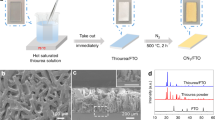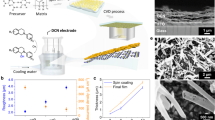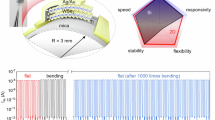Abstract
Despite its versatility in photocatalysis, the application of carbon nitride (CN) to optoelectronic devices, especially silicon (Si) optoelectronics, has been constrained by a lack of synthetic methods for producing large-scale, highly uniform and processable films. Here we report a large-scale synthesis of ultrathin amorphous carbon nitride (aCN) on Si, achieving high uniformity, ultralow surface roughness and a covalently bonded interface with Si. The ultrathin aCN on Si (aCN/Si) is synthesized via a two-step process involving a dual-heating-zone chemical vapour deposition and subsequent postannealing in a hydrogen atmosphere. During the postannealing process, the initially formed bilayer of polymeric CN and underlying aCN undergoes material transformations, including thinning of the CN film, increasing spatial uniformity and covalent bond formation between nitrogen and silicon atoms, producing a high-quality aCN/Si heterostructure. Based on this aCN/Si, we developed vertical photodiodes that function both as electrical diodes with high rectification ratio (3.8 × 108) and photodetectors with high specific detectivity (1.9 × 1012 Jones), fast photoresponse (6.7 µs) and a broad linear dynamic range (>130 dB). Integrating these aCN/Si vertical photodiodes with amorphous indium-gallium-zinc oxide switching thin-film transistors enables active-matrix-based multispectral imaging across the visible to near-infrared spectrum range.

This is a preview of subscription content, access via your institution
Access options
Subscribe to this journal
Receive 12 digital issues and online access to articles
118,99 € per year
only 9,92 € per issue
Buy this article
- Purchase on SpringerLink
- Instant access to full article PDF
Prices may be subject to local taxes which are calculated during checkout




Similar content being viewed by others
Data availability
All data are available within the Article and its Supplementary Information. Source data are provided with this paper.
References
Wang, X. et al. A metal-free polymeric photocatalyst for hydrogen production from water under visible light. Nat. Mater. 8, 76–80 (2009).
Zheng, Y., Liu, J., Liang, J., Jaroniec, M. & Qiao, S. Z. Graphitic carbon nitride materials: controllable synthesis and applications in fuel cells and photocatalysis. Energy Environ. Sci. 5, 6717–6731 (2012).
Zhang, J., Chen, Y. & Wang, X. Two-dimensional covalent carbon nitride nanosheets: synthesis, functionalization, and applications. Energy Environ. Sci. 8, 3092–3108 (2015).
Ong, W.-J., Tan, L.-L., Ng, Y. H., Yong, S.-T. & Chai, S.-P. Graphitic carbon nitride (g-C3N4)-based photocatalysts for artificial photosynthesis and environmental remediation: are we a step closer to achieving sustainability? Chem. Rev. 116, 7159–7329 (2016).
Bajada, M. A. et al. Light-driven C–O coupling of carboxylic acids and alkyl halides over a Ni single-atom catalyst. Nat. Synth. 2, 1092–1103 (2023).
Tan, H. et al. Photocatalysis of water into hydrogen peroxide over an atomic Ga-N5 site. Nat. Synth. 2, 557–563 (2023).
Wang, X., Blechert, S. & Antonietti, M. Polymeric graphitic carbon nitride for heterogeneous photocatalysis. ACS Catal. 2, 1596–1606 (2012).
Noda, Y. et al. Directional charge transport in layered two-dimensional triazine-based graphitic carbon nitride. Angew. Chem. Int. Ed. 58, 9394–9398 (2019).
Zhang, J., Zhang, M., Sun, R.-Q. & Wang, X. A facile band alignment of polymeric carbon nitride semiconductors to construct isotype heterojunctions. Angew. Chem. 124, 10292–10296 (2012).
Kessler, F. K. et al. Functional carbon nitride materials—design strategies for electrochemical devices. Nat. Rev. Mater. 2, 17030 (2017).
Liu, J., Wang, H. & Antonietti, M. Graphitic carbon nitride ‘reloaded’: emerging applications beyond (photo)catalysis. Chem. Soc. Rev. 45, 2308–2326 (2016).
Liu, Z. et al. Wafer-scale growth of two-dimensional graphitic carbon nitride films. Matter 4, 1625–1638 (2021).
Fu, J., Yu, J., Jiang, C. & Cheng, B. g-C3N4-based heterostructured photocatalysts. Adv. Energy Mater. 8, 1701503 (2018).
Zhao, D. et al. Boron-doped nitrogen-deficient carbon nitride-based Z-scheme heterostructures for photocatalytic overall water splitting. Nat. Energy 6, 388–397 (2021).
Prakash, N. et al. Binary multifunctional ultrabroadband self-powered g-C3N4/Si heterojunction high-performance photodetector. Adv. Opt. Mater. 6, 1800191 (2018).
Park, H.-L. et al. Retina-inspired carbon nitride-based photonic synapses for selective detection of UV light. Adv. Mater. 32, 1906899 (2020).
Chen, X. et al. Ultrasensitive broadband position-sensitive detector based on graphitic carbon nitride. Nano Res. 16, 1277–1285 (2023).
Ghosh, A. et al. Nitrogen vacancy and hydrogen substitution mediated tunable optoelectronic properties of g-C3N4 2D layered structures: applications towards blue LED to broad-band photodetection. Appl. Surf. Sci. 556, 149773 (2021).
Wang, Y. et al. A warm-white light-emitting diode based on single-component emitter aromatic carbon nitride. Nat. Commun. 13, 6459 (2022).
Park, S. et al. Production of C, N alternating 2D materials using covalent modification and their electroluminescence performance. Small Sci. 1, 2000042 (2021).
Xu, J. et al. Liquid-based growth of polymeric carbon nitride layers and their use in a mesostructured polymer solar cell with Voc exceeding 1 V. J. Am. Chem. Soc. 136, 13486–13489 (2014).
Zhou, L. et al. Ultrathin two-dimensional graphitic carbon nitride as a solution-processed cathode interfacial layer for inverted polymer solar cells. J. Mater. Chem. A 4, 8000–8004 (2016).
Niu, P., Zhang, L., Liu, G. & Cheng, H.-M. Graphene-like carbon nitride nanosheets for improved photocatalytic activities. Adv. Funct. Mater. 22, 4763–4770 (2012).
Yang, S. et al. Exfoliated graphitic carbon nitride nanosheets as efficient catalysts for hydrogen evolution under visible light. Adv. Mater. 25, 2452–2456 (2013).
Algara-Siller, G. et al. Triazine-based graphitic carbon nitride: a two-dimensional semiconductor. Angew. Chem. Int. Ed. 53, 7450–7455 (2014).
Shalom, M. et al. Controlled carbon nitride growth on surfaces for hydrogen evolution electrodes. Angew. Chem. Int. Ed. 53, 3654–3658 (2014).
Qin, J. et al. Direct growth of uniform carbon nitride layers with extended optical absorption towards efficient water-splitting photoanodes. Nat. Commun. 11, 4701 (2020).
Akinwande, D. et al. Graphene and two-dimensional materials for silicon technology. Nature 573, 507–518 (2019).
Zhao, Y. et al. Doping, contact and interface engineering of two-dimensional layered transition metal dichalcogenides transistors. Adv. Funct. Mater. 27, 1603484 (2017).
Hoang, A. T., Hu, L., Katiyar, A. K. & Ahn, J.-H. Two-dimensional layered materials and heterostructures for flexible electronics. Matter 5, 4116–4132 (2022).
Bian, Z., Miao, J., Zhao, Y. & Chai, Y. Strong interlayer interaction for engineering two-dimensional materials. Acc. Mater. Res. 3, 1220–1231 (2022).
Niu, P., Yin, L.-C., Yang, Y.-Q., Liu, G. & Cheng, H.-M. Increasing the visible light absorption of graphitic carbon nitride (melon) photocatalysts by homogeneous self-modification with nitrogen vacancies. Adv. Mater. 26, 8046–8052 (2014).
Tu, W. et al. Investigating the role of tunable nitrogen vacancies in graphitic carbon nitride nanosheets for efficient visible-light-driven H2 evolution and CO2 reduction. ACS Sustain. Chem. Eng. 5, 7260–7268 (2017).
Kim, S. et al. Orthogonal dual photocatalysis of single atoms on carbon nitrides for one-pot relay organic transformation. ACS Nano 17, 21470–21479 (2023).
Zou, C. et al. Fabrication and properties of borazine derived boron nitride matrix wave-transparent composites reinforced by 2.5 dimensional fabric of Si–N–O fibers. Mater. Sci. Eng. A 620, 420–427 (2015).
Kang, Y. et al. An amorphous carbon nitride photocatalyst with greatly extended visible-light-responsive range for photocatalytic hydrogen generation. Adv. Mater. 27, 4572–4577 (2015).
Wang, H. et al. Ultralow-dielectric-constant atomic layers of amorphous carbon nitride topologically derived from MXene. Adv. Mater. 35, 2301399 (2023).
Li, B. et al. Patterning of wafer-scale MXene films for high-performance image sensor arrays. Adv. Mater. 34, 2201298 (2022).
Seung, H. et al. Integration of synaptic phototransistors and quantum dot light-emitting diodes for visualization and recognition of UV patterns. Sci. Adv. 8, eabq3101 (2022).
Katiyar, A. K. et al. 2D materials in flexible electronics: recent advances and future prospectives. Chem. Rev. 124, 318–419 (2023).
Gu, L. et al. A biomimetic eye with a hemispherical perovskite nanowire array retina. Nature 581, 278–282 (2020).
Long, Z. et al. A neuromorphic bionic eye with filter-free color vision using hemispherical perovskite nanowire array retina. Nat. Commun. 14, 1972 (2023).
Lemme, M. C., Akinwande, D., Huyghebaert, C. & Stampfer, C. 2D materials for future heterogeneous electronics. Nat. Commun. 13, 1392 (2022).
Acknowledgements
D.-H.K. and T.H. acknowledge support from the Institute for Basic Science (grant nos. IBS-R006-A1 and IBS-R006-D1, respectively). C.C. acknowledges support from the National Research Foundation of Korea grant funded by the Korean government (MSIT) (grant no. RS-2023-00209466) and the Future Resource Research Program of the Korea Institute of Science and Technology (KIST) (grant no. 2E33542).
Author information
Authors and Affiliations
Contributions
H.S. and J.B. conceived the idea. H.S. and J.B. designed the experiments, performed the material synthesis and analysed the data. C.C., D.-H.K. and T.H. supervised the project. H.S., J.B., J.S.K., C.C., T.H. and D.-H.K. wrote and revised the paper. H.S., J.B. and J.K. built the synthesis setup under the supervision of J.P. H.S. and H.C. fabricated the devices. H.S., C.C., J.A. and J.P.H. performed the device measurements under the supervision of D.K.H. L.C. performed the low-energy electron diffraction (LEED) analysis. E.Y., S.B. and S.P. analysed the band alignment using UPS and IPES. Y.Y.K. performed grazing incidence wide-angle X-ray scattering analysis. All authors discussed the results and commented on the manuscript.
Corresponding authors
Ethics declarations
Competing interests
The authors declare no competing interests.
Peer review
Peer review information
Nature Synthesis thanks Michael Bojdys and the other, anonymous, reviewer(s) for their contribution to the peer review of this work. Primary Handling Editor: Alexandra Groves, in collaboration with the Nature Synthesis team.
Additional information
Publisher’s note Springer Nature remains neutral with regard to jurisdictional claims in published maps and institutional affiliations.
Extended data
Extended Data Fig. 1 Vertical structure of carbon nitride and silicon.
a, Cross-sectional TEM images of the edge parts of sample (1) (left), sample (4) (middle), and sample (7) (right). The sampling spots are marked with red stars in insets (sampling position 10 in Fig. 1e). b-e, Cross-sectional TEM images of the central parts of sample (1) (b), sample (6) (c), sample (7) (d), and sample (8) (e) grown on the p-Si wafer.
Extended Data Fig. 2 Surface morphologies of the samples (1) and (6)-(8).
a-d, AFM surface profile of sample (1) (a), sample (6) (b), sample (7) (c), and sample (8) (d). Three different points for each sample were measured.
Extended Data Fig. 3 Underlying aCN in sample (1).
a,b, Cross-sectional TEM images of the sample (1), after being washed with water to remove the top pCN layer. Three different spots were investigated, marked with red stars in insets; sampling position 8 (a, left), 10 (a, right), and 6 (b) as in Fig. 1e. The underlying aCN layer with the thickness of < 2 nm was visible in all three areas. However, in position 6 (b), the pCN residue was observed. Please see Supplementary Note 1 for details.
Extended Data Fig. 4 Crystallinity of sample (1) and sample (7) measured by grazing incidence wide-angle X-ray scattering (GIWAXS).
a,b, GIWAXS mapping diagrams (a) and horizontal cut graphs (b) of sample (1) (left) and sample (7) (right), measured at the center. c,d, GIWAXS mapping diagrams (c) and horizontal cut graphs (d) of sample (1) (left) and sample (7) (right), measured at the edge.
Extended Data Fig. 5 XPS N1s spectra of samples (1)-(5) and (7).
a,b, XPS N1s spectra of samples (1)-(5) and (7), measured at the center (a) and the edge (b) of each sample. Sample (7) (aCN (20 min)) represents the properties of ultrathin aCNs (samples (6)-(8)).
Extended Data Fig. 6 XPS C1s spectra of samples (1) and (7).
a,b, XPS C1s spectra of sample (1) (left) and sample (7) (right), measured at the center (a) and the edge (b) of each sample.
Extended Data Fig. 7 Patterning ultrathin aCN by conventional photolithography process.
a,b, Sample (7) was patterned into the shapes of the symbols of Seoul National University (a) and the circles with the diameters of 3 μm, 5 μm, 7 μm, and 10 μm (b).
Extended Data Fig. 8 Comparison of device performances of vertical photodiodes.
a, Histogram of rectification ratios measured from 120 random devices. b,c, I–V curves of vertical photodiodes with pCN/p-Si (b) and p-Si (c) sandwiched between the Ti/Au top electrode and the Au bottom electrode, under the irradiation of 638 nm light of different intensities. The lowest detectable intensity was 15.9 mW cm−2 and 0.2 mW cm−2 for each case. d, Iph of the aCN/p-Si device (red) compared to those of p-Si device (blue) and pCN/p-Si device (black) according to the 638 nm light intensities at Vd = 0 V. e, Specific detectivity (D*) of aCN/p-Si vertical photodiode (red) compared to those of p-Si device (blue) and pCN/p-Si device (black), according to the light intensities at Vd of 0 V. f,g, Spectral responsivity (f) and external quantum efficiency (EQE) (g) of aCN/p-Si device.
Extended Data Fig. 9 Fabrication and measurement set up of 1T1P active-matrix image sensor array.
a, Schematic illustration showing the fabrication procedure of 1T1P active-matrix image sensor array. Each pixel consists of an aCN/p-Si vertical photodiode and an a-IGZO TFT. b, Transfer curve of the a-IGZO TFT. c, Experimental setup for multispectral imaging demonstration performed by our active-matrix device. Photographs on the right show the shadow masks of “S” (top) and “N” (bottom) on top of the device. Each inset shows the 625 nm and 532 nm light shaped the alphabet “S” and “N”, respectively.
Supplementary information
Supplementary Information
Supplementary Notes 1–5, Tables 1 and 2, Figs. 1–11 and References.
Supplementary Data Fig. 4
Source data for Supplementary Fig. 4.
Supplementary Data Fig. 6
Source data for Supplementary Fig. 6.
Supplementary Data Fig. 7
Source data for Supplementary Fig. 7.
Supplementary Data Fig. 8
Source data for Supplementary Fig. 8.
Supplementary Data Fig. 9
Source data for Supplementary Fig. 9.
Supplementary Data Fig. 10
Source data for Supplementary Fig. 10.
Supplementary Data Fig. 11
Source data for Supplementary Fig. 11.
Source data
Source Data Fig. 1
Numerical source data for Fig. 1.
Source Data Fig. 2
Numerical source data for Fig. 2.
Source Data Fig. 3
Numerical source data for Fig. 3.
Source Data Fig. 4
Numerical source data for Fig. 4.
Source Data Extended Data Fig. 4
Numerical source data for Extended Data Fig. 4.
Source Data Extended Data Fig. 5
Numerical source data for Extended Data Fig. 5.
Source Data Extended Data Fig. 6
Numerical source data for Extended Data Fig. 6.
Source Data Extended Data Fig. 8
Numerical source data for Extended Data Fig. 8.
Source Data Extended Data Fig. 9
Numerical source data for Extended Data Fig. 9.
Rights and permissions
Springer Nature or its licensor (e.g. a society or other partner) holds exclusive rights to this article under a publishing agreement with the author(s) or other rightsholder(s); author self-archiving of the accepted manuscript version of this article is solely governed by the terms of such publishing agreement and applicable law.
About this article
Cite this article
Seung, H., Bok, J., Kim, J.S. et al. Covalent heterostructures of ultrathin amorphous carbon nitride and Si for high-performance vertical photodiodes. Nat. Synth 4, 514–522 (2025). https://doi.org/10.1038/s44160-024-00730-2
Received:
Accepted:
Published:
Issue Date:
DOI: https://doi.org/10.1038/s44160-024-00730-2



